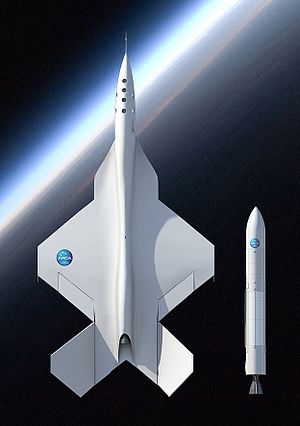IAR 111
This article has multiple issues. Please help improve it or discuss these issues on the talk page. (Learn how and when to remove these messages)
|
| IAR-111 Excelsior | |
|---|---|

| |
| IAR-111 and Haas 2 rocket | |
| Role | Supersonic mothership |
| National origin | Romania |
| Manufacturer | ARCA Space |
| Designer | ARCA Space |
The IAR-111 Excelsior is a supersonic mothership project,[citation needed] designed by ARCA Space Corporation, intended to transport a rocket payload up to 18,000 m (59,000 ft) and for developing space tourism related technologies. The aircraft is to be constructed almost entirely from composite materials, and will be designed for take-off and landing from the sea surface.[citation needed]
History
The design of the aircraft started before the successful launch of the Helen 2 rocket. ARCA kept work on the project secret and decided to reveal it to the public in a press conference that took place at BRD headquarters in Bucharest in December 2010. The initial name of the aircraft was E-111.[1] In March 2011 ARCA received approval from IAR S.A. Brasov to use its initials on the aircraft, so E-111 was officially renamed IAR-111.
Work on the fuselage moulds started in early 2011 and were completed in September. The cockpit structure was completed in July. It is detachable from the rest of the aircraft and will be equipped with two rocket propelled parachutes (main and back-up) as a safety system. Also in September the CFD simulations for the aircraft were completed. On 29 September 2011, a successful cockpit drop-test was carried out. A Mi-17 helicopter dropped the cockpit from 700 m (2,300 ft) to test the parachute recovery system.[2] In December 2011, the first two sections of the aircraft fuselage were completed and preliminary assembled.[3]
Design
Features
The IAR-111 is designed to take-off and land on the sea surface.[citation needed] ARCA decided to use this approach to eliminate the need for a landing gear and thus reduce the cost of the aircraft. Another factor that went into the decision was the fact that Romania has no unpopulated areas above which to safely test the aircraft to high altitude flights.
The aircraft has diamond-shaped wings to reduce weight, and lower drag at high speeds; "V" tails were chosen to avoid contact with the water on take-off and landing. It has two floats and the payload is located between them, acting as a third float. The payload will be either the Haas 2 rocket or an external fuel tank.
For aerodynamic surface control it will use a hydraulic system controlled by fly-by-wire from the cockpit. The aircraft will be powered by the new Executor liquid-fuelled rocket engine, under construction at ARCA, which will use kerosene as fuel and liquid oxygen as oxidizer.[4]
Safety
The cockpit walls and windows are very thick, able to withstand an engine explosion.[clarification needed] Additionally, the cockpit is detachable and is equipped with two rocket propelled parachutes (main and back-up). The aircraft will have a very large recovery parachute and a smaller anti-stall parachute.[citation needed]
Mission 6 tested the safety systems with a drop test from 700 m (2,300 ft). One of the parachutes was opened to test the explosive bolts. The test was a success and the cabin was recovered in good condition.[citation needed]
Specifications
The specifications released to date are approximate design goals, and include:[citation needed]
Data from ARCA[5]
General characteristics
- Crew: 2
- Length: 24 m (78 ft 9 in)
- Wingspan: 12 m (39 ft 4 in)
- Height: 5 m (16 ft 5 in)
- Wing area: 100 m2 (1,100 sq ft)
- Empty weight: 7,200 kg (15,873 lb)
- Gross weight: 19,000 kg (41,888 lb)
- Max takeoff weight: 23,000 kg (50,706 lb)
- Powerplant: 1 × Executor liquid-fuelled rocket engine, 200 kN (44,000 lbf) thrust
Performance
- Maximum speed: Mach 2.6
- Service ceiling: 100,000 m (330,000 ft)
- Rate of climb: 250 m/s (49,000 ft/min)
- Wing loading: 230 kg/m2 (47 lb/sq ft)
- Thrust/weight: 2.316
See also
- Northrop YF-23, similar wing and tail shape
- Boeing NB-52 & North American X-15
- Pegasus (rocket)
- Shuttle Carrier Aircraft
- SpaceShipOne
References
- ^ Radu, Dan (22 December 2010). "Cum arată primul avion supersonic Românesc. Inginerii de la ARCA lucrează la prototip. Vezi aici simulare video şi galerie foto cu E-111" [What the first Romanian supersonic aircraft looks like. ARCA engineers are working on the prototype. View this video simulation and photo gallery of the E-111]. Gândul (in Romanian). Retrieved 18 March 2012.
- ^ "Cabina primului supersonic românesc IAR-111, testată cu succes în zbor. Ne pregătim pentru turism spaţial?" [Cabin of the first Romanian supersonic IAR-111, successfully tested in flight. Preparing for space tourism?]. Adevărul (in Romanian). 29 September 2011. Retrieved 18 March 2012.
- ^ "Primul avion supersonic românesc, aproape de finalizare: 60% din structura IAR-111, realizată" [First Romanian supersonic aircraft nearing completion: 60% of the structure of IAR-111 achieved]. Mediafax (in Romanian). 13 December 2011. Retrieved 18 March 2012.
- ^ "Executor Rocket Engine". ARCA Space Corporation. Archived from the original on 9 October 2014.
- ^ "IAR-111 Excelsior". ARCA Space Corporation. Retrieved 30 January 2016.
